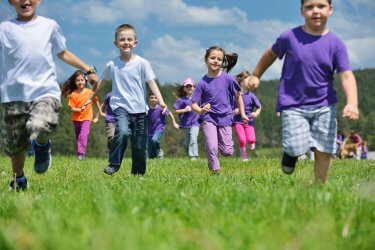Student lives are packed with school, homework, entertainment, social media and much more. This leaves little time for healthy eating and exercising. Understanding how to fit healthy meals and exercise into busy school days affects the ability of our students to meet the high demands of a busy life while simultaneously maintaining short and long-term health. Physical activity, good nutrition, and a healthy mind set, build the foundation for a well-rounded childhood. Questions about whether or not to eat breakfast, what to eat for breakfast, when to exercise, and how many hours of sleep are needed, are often confusing topics with many differing opinions. In this article, we address some common topics relating to how to start the day based on research-proven strategies for dealing with the fast-paced environment in which today’s students live.

Habits
Habits are regular tendencies and practices followed with little conscious effort. Habits are born out of long-term consistent routines. The more consistent students are with sleeping, eating right, and exercising, the greater likelihood they will become habits. Although changing our daily lifestyles can be difficult, one effective strategy is to set the goal of practicing 3-4 new behaviors for 30 days. These new goals should be written down and read daily. After 30 days students often discover that the new behaviors are taking less effort and starting to become second nature “habits.” But remember, it’s important to ensure routines (e.g. to eat breakfast everyday) are also consistently healthy (i.e. include meals that are well-balanced). Because lifelong habits can good or bad for your well-being, it’s vital our students’ choices are good!
Have Plenty of Choices
School-age children often don’t like doing the same thing over and over again. Routines that don’t include variety can become boring. But including variety doesn’t have to take away from the goal of developing consistent habits, but rather emphasizes the importance of providing choices within behaviors. Students need to have plenty of healthy choices for food and different options for staying physically active. Mixing it up is fun, refreshing, and something to look forward to doing rather than disliking.

Get Enough Rest
Sleep is important for healthy growth and recovery. Research shows that insufficient sleep or inconsistent sleep times are associated with weight gain, increased stress, behavioral problems, and several chronic diseases (Medic, Wille, & Hemels, 2017). The average sleeping time for most people is between 7-9 hours. However, during the school week children often lack sleep because of poor time management and incorrect estimations of how long homework will take to complete. Getting enough sleep is important but also being consistent in “sleeping and waking times” affects energy. Sometime referred to as “jet-lag,” even if students are getting sufficient sleep, shifts in time may make them feel not rested, tired, or exhausted during the day. Lack of sleep and inconsistent sleep times have been linked to higher body mass index (BMI) and poor academic performance. Some studies such as have suggested that longer sleep durations (10 hours) during school days can have positive effects on both weight management and school functioning (Altenburg et al, 2013).

Breakfast
The importance of eating breakfast has been discussed by educators for many years and is often promoted as essential for academic performance, weight management, and as a part of a healthy lifestyle. A number of studies have focused on children and breakfast programs (Hoyland, 2009, Betts, 2016). Their findings revealed a relationship between breakfast and improved cognitive performance, especially with children from low income areas where they may be undernourished. Children who are otherwise healthy also experience a cognitive performance benefit from eating breakfast especially if it improves their school attendance. Of course, the nutritional value of the food they eat is also important and should ideally always be the healthiest and well balanced as possible. And older high school teenagers can also benefit from regular breakfast consumption. Benefits include increased energy, higher metabolisms, and the discovery that it’s easier to maintain a healthier body composition.
Nutrition
We need to encourage our students to try to ensure their breakfasts include “protein rich foods,” “high fiber foods,” and foods with “complex carbohydrates,” all of which have been shown to be more satiating and provide longer lasting energy with better health benefits (Leidy, 2015). Sugar-sweetened cereals, pancakes with syrup, breads with lots of jam, and sugary muffins are common quick student choices for breakfast. Boosting blood sugar to high levels is not good if the child is only going to sit in class the entire morning and not exercise to burn the accumulated calories. As weight management and diabetes continue to become serious youth health concerns, adding fiber and protein to student diets will make breakfast more helpful than detrimental. Examples of good breakfast choices to start the day include foods such as boiled or scrambled eggs, lightly-sweetened oatmeal, lean meat, whole grain bread, unsweetened yogurt with fruit, or non-starchy vegetables.

Vitamins and Minerals
Children often skip breakfast at home and only eat half what is offered by the school cafeteria, choosing to visit “fast food restaurants” later that day. Several things are wrong with this picture including the risk of not getting enough nutrients. Taking a daily vitamin and mineral supplement in the morning should be considered as an effective way of ensuring student bodies are getting the key nutrients they need. Children need good nutrition to develop and grow to their potential and taking a multi-vitamin is a recommended preventive measure (Leidy, 2015). Several companies now produce chewable “gummy” vitamins making is easier and more likable for younger students to take.

Hydration is Key
Drinking enough water daily is often overlooked, not scheduled, and doesn’t become a regular habit for many school-age children. Hydration status in schools have shown to be a problem, close monitoring by administration could help (Micheals, 2017). Studies have shown that 6-8 drinks daily starting with morning breakfast helps get the digestive system ready for the day and may improve school performance (National Hydration Council, 2019). Additionally, during sleeping or long periods of rest we often don’t realize that our bodies are using a lot of water to maintain homeostasis Specifically, drinking plenty of water helps keep our body systems balanced. Developing the habit of drinking water first thing in the morning is a good way to replenish water loss after sleep, combat signs of dehydration, and also prepares the stomach for digestion.
Hygiene is a Must
Basic hygiene typically includes tasks such as washing hands and face, brushing teeth, mouth rinsing, regular showering, using deodorant, and keeping ears clean. Starting the day with good hygiene helps students with the transition from sleep to awake, makes them feel better, and increases their confidence at school. Further, good hygiene helps prevent diseases (mouth, skin, hair) and as with other habits needs to be developed as part of a daily routine. Most hygiene tasks do not take much time and effort, but the positive effects are lasting and improve the likelihood for a productive school day.

Get Moving
Years ago, when many children grew up on farms, they began each day with chores (e.g. feeding livestock, gathering eggs, cutting wood, etc.) that required physical labor. Today, few children live on farms and many start the day playing video games, watching TV, or online with social media. Many schools only schedule elementary students a few hours (or less!) of physical education or physical activity a week and require high schoolers to take physical education only 1 out of 4 years, instead emphasizing academics and homework. For most students, physical activity is not a part of daily living which begs the question “When are school-aged children going to play, exercise or be physically active?” Parents and teachers need to work out ways to make physical activity a daily priority, indeed a habit that children learn to value and integrate into their lives. With help from both parents and teachers a morning exercise session could benefit students by controlling appetite and calorie intake throughout the day (Alizadeh, 2017).
Conclusion
Parents and teachers can and should help students to develop morning habits that will improve their health and help them to be successful in the school day ahead. Healthy habits will prepare our students for success not only today but in their future lives.
References
Alizadeh, Z., Younespour, S., Rajabian Tabesh, M., & Haghravan, S. Comparison between the Effect of 6 Weeks of Morning or Evening Aerobic Exercise on Appetite and Anthropometric Indices: A Randomized Controlled Trial. Clin Obes. 2017 Jun;7(3):157-165. doi: 10.1111/cob.12187. Epub 2017 Mar 26.
Altenburg, T. M., Chinapaw, M. J., van der Knaap, E. T., Brug, J., Manios, Y., & Singh, A. S. (2013). Longer sleep-slimmer kids: the ENERGY-project. PLoS One. 2013;8(3): e59522.
Betts, J.A., Chowdhury, E.A., Gonzalez, J.T., Richardson, J.D., Tsintzas, K., & Thompson, D. (2016). Is breakfast the most important meal of the day? Proceedings of the Nutrition Society 75, 464–474. doi:10.1017/S0029665116000318
Hoyland, A., Dye, L., & Lawton, C. (2009). A systematic review of the effect of breakfast on the cognitive performance of children and adolescents. Nutrition Research Reviews,22(2), 220-243. doi:10.1017/S0954422409990175
Leidy, H.J., Clifton, P.M., Astrup, A., Wycherley, T.P., Westerterp-Plantenga, M.S., Luscombe-Marsh, N.D., Woods, S.C., & Mattes, R.D. (2015) The role of protein in weight loss and maintenance, The American Journal of Clinical Nutrition, 101 (6), 1320S–1329S.https://doi.org/10.3945/ajcn.114.084038
Medic, G., Wille, M., & Hemels, M. E. (2017). Short- and long-term health consequences of sleep disruption. Nature and science of sleep, 9, 151-161. doi:10.2147/NSS.S134864.https://www.ncbi.nlm.nih.gov/pmc/articles/PMC5449130/
Michels, N., Van den Bussche, K., Vande Walle, J., & De Henauw, S. (2017) Belgian Primary School Children’s Hydration Status at School and Its Personal Determinants.” Eur J Nutr. 2017 Mar;56(2):793-805. doi: 10.1007/s00394-015-1126-4. Epub 2015 Dec 16.
National Hydration Council (2019). Retrieved fromhttps://www.naturalhydrationcouncil.org.uk/hydration-facts/hydration-and-water-facts-for-kids-2/
